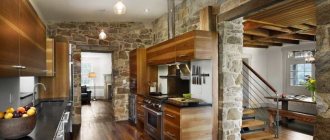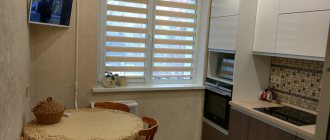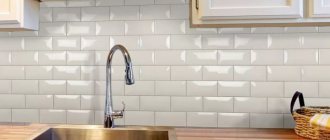Our contemporaries are increasingly undertaking grandiose redevelopments in their apartments, filling old interiors with new structures such as plasterboard niches, glass partitions and the like. Doorways are not left unattended either. Their traditional rectangular shape is replaced with an arched one. The general decor of the door area is also changing. Instead of the usual platbands, the arch is finished with decorative stone. Most often, they get rid of extra doors in rooms with high traffic, for example, in the kitchen or living room. And this step is completely justified. Remember how many times a day you have to open the doors to these rooms. There is also no point in having a door that is constantly open, so it is quite logical to get rid of it, replacing it with such a magnificent design as an arch.
finishing the arch with decorative stone
By the way, an interior arch is a great way to add originality to your home interior. She is always the center of attention. Someone, looking at it, will remember the Arc de Triomphe, for someone it will remind the entrance to a mysterious cave or grotto - everything will depend on the specifics of the decoration of the surrounding space. In general, the use of arched openings in the design adds space and comfort to the house.
Tips for decorating an arch with a corner with your own hands
Depending on the characteristics of the material from which the selected corners are made, they can be fixed with liquid nails, sealant, or special glue.
Sometimes the easiest way is to use the old, proven method - a hammer and small nails. In any case, the main thing in the work will be consistency and accuracy. If the corners have not been previously prepared for fixation, you will need to trim their edges. This will allow you to achieve optimal connection of fragments and obtain a beautiful, holistic result. Facing an arched opening is a process that requires care and diligence. However, there is nothing complicated in such work. That is why you can safely choose the material you like and experiment.
Briefly about the main thing
Arched structures remain exotic for European interiors, despite the fact that this architectural element was popular back in Ancient India. In modern houses and apartments there are arches of different designs, but their cladding with decorative stone causes difficulties in choosing the appropriate option.
Specialized stores offer decorative stones of various appearances with a gypsum, sand-cement, or acrylic base. It is made in the form of tiles of different proportions and thicknesses, with different decorative properties: shade, texture and relief.
The tiles for arch design are selected taking into account the shape of the structure and the material from which it is made
It is also important that the decorative stone matches the style of the interior
Required tools and materials
Before starting work, you should prepare all the necessary tools and materials. Let's start with the last ones. First of all, naturally, you will need a decorative stone. Considering the fact that the work will be carried out indoors, you can use both natural and artificial stone, since in this case the resistance of the material to “external irritants” is practically unimportant. So you can choose a stone based solely on your aesthetic preferences and financial capabilities. In addition to the stone itself, you will need glue or mortar, a primer, grout and a special composition to protect the walls from moisture - a water repellent. Also, putty can be useful for preliminary preparation of the surface of the arch.
A knitwear motif appears many times, most often consisting of two ribbons. Tympanons of windows, oiled vine leaves or knitters between two lines are filled with fantastic and real animals and birds and religious scenes. The flat relief, somewhat reminiscent of woodcut, is close to the popular motifs of embroidery and lace.
Some paintings survive in some Moravian group churches. The most significant are the frescoes of the Temple of the Savior in the Ravanica monastery and the Church of St. In Ravanica there is a wonderful fragmentary surviving group portrait of the founders of the temple: Prince Lazar, his wife Milis and sons Stefan and Vuki. “The Entry of the Lord into Jerusalem” on the frescoes of this temple develops against a complex architectural background and turns into a truly mass scene. The elongated figures excel in their softness and grace, the linearity is enhanced in their rendering, and the brush painting style appears here for the iconostatic design.
The tools you will need are a building level, a spatula, a construction mixer, tile nippers or a cutting machine, a trowel, a bucket, a tape measure, paint brushes, a metal brush, a rubber mallet, plastic or wooden wedges of the same thickness, and for the final finishing – a household spray bottle.
Serbian wall paintings retained their high artistic qualities during this period. The last Serb battalion in the battle against the Turks was the Smederevo fortress on the Danube: an impressive defensive structure consisting of two rows of brick and stone walls. After the conquest of Smederev Turk, construction in Serbia was not yet over, although it was greatly weakened.
Serbian medieval art played an important role in its time. Particularly noteworthy are the centuries that are of paramount importance for the art of all of Eastern Europe. Serbian painting, full of emotional tension, opened up wonderful opportunities for artists to express human feelings and passions. The introduction of new iconographic themes and types allowed Serbian masters to capture far beyond the real world, without going beyond religious canons. Serbian art has enriched the iconography of many countries.
Having prepared everything you need, you can begin work on decorating the arch with stone, which should begin with careful preparation of the surface.
What else will you need?
To finish the arch, you will need at least the following tools: what you will use to cut the stone (hand saw or grinder), a construction knife, a level, a hammer, sandpaper, a chisel, and glue.
The step-by-step cladding process looks like this:
- Cut the decorative stone into several pieces or thin tiles. Prepare the surface of the arch in advance by cleaning it from dust and dirt, old wallpaper, paint and whitewash. Make several notches, which will allow the glue to stick better. You can also apply a primer, after which it is important to dry the structure.
- Having prepared “liquid nails”, cement mortar or some other adhesive composition, start gluing the tiles from the bottom of the arch, from its junction with the floor. Pay attention to the weight of the stone - some brands are not able to bear heavy samples. Apply glue to the wall using a spatula and press the stones firmly, but do not overdo it, otherwise cracks will occur. Leave a gap of 5 millimeters between them. Keep in mind that adhesion will be higher if the tile contains the same ingredient as the surface on which it is glued.
- Work a row on both sides of the arch, and then move on to the next one. Line each one up using a level and use plastic crosses. If there are corner stones, then use them to decorate the corners. If there are none, then overlap flat ones - this way you will give the structure stability.
- After this, proceed to rounding. At this stage, you need to cut the stone yourself to give it the desired shape, using a grinder, a construction knife or wire cutters. To smooth out uneven surfaces, use sandpaper and a file. Partially lay the stone on the nearby wall surface.
- After a couple of days, when everything has dried and set, start filling the tile joints with cement mortar or grout. You can choose grout of any color, depending on the design of the room. Avoid contact of liquid with the surface of the stone; remove any excess immediately with a soft cloth. After the arch is completely dry, coat it with acrylic varnish or even paint it. Small errors are hidden using an airbrush.
You will learn even more information about how to make a stone arch in the interior from the following video.
What tools and materials are required for finishing arches with stone?
When carrying out the work, the main difficulty is the fact that it is necessary to cover not only the flat surface, but also the inner rounded part of the arch. If you carefully read all the nuances of the process, stone finishing will no longer seem so complicated; you can do it yourself.
To finish the arch, before starting work you need to prepare the following tool:
- pliers;
- pickaxe;
- roller;
- saw;
- primer;
- building level;
- putty knife;
- knife for construction work;
- sandpaper;
- pencil.
In addition to this you will need:
- stone;
- liquid nails or glue;
- cement mortar;
- solution for sealing joints.
Sealing seams
If you laid decorative stone “under the jointing”, then you will need to fill the space between the stones with a special grout. For this purpose, you can use a grout similar to that used for tile joints. However, given that the seams between stones are much wider than the seams between tiles, the technology for applying grout in this case will be different. If a spatula is used in a situation with tiles, then when working with decorative stone it is better to use a construction syringe. If you don’t have one, you can use a regular plastic bag, having previously cut off one of the corners in it.
You can seal the seams with a construction syringe
To do this, the grout powder should be diluted to the consistency of “liquid sour cream” and poured into a construction syringe. After this, slowly squeezing out the contents of the syringe to fill the space of the seams between the stones.
If you want to emphasize the relief of the masonry, then fill the seams to about half their depth. If, on the contrary, you want to smooth out excessive texture, fill the seams completely.
30-40 minutes after applying the grout, the seams should be given a “shape” using for this purpose a special shaped spatula or, in its absence, any object with a rounded end, for example, the back of a paint brush handle.
Advantages
To decorate the arch, choose one of two types of stones - artificial or natural. Each type has its own advantages.
Natural materials are characterized by the following characteristics:
- They have a very interesting texture. Such stones look unusual - both on the pages of magazines and photographs, and upon closer examination. These include shell rock and sandstone.
- Lovers of delicate colors in the interior should choose arches lined with marble. This stone is available in various shades of pink; the pastel color looks very neat and unobtrusive.
- To emphasize their status, buyers often choose arches trimmed with granite. This material is very expensive, but it gives the interior solidity and is a sign of financial well-being.
Artificial decorative stones also have their advantages:
- They are made of such high quality that they can hardly be distinguished from natural materials.
- The price for such material is affordable. You can decorate the vault with a large number of stones without worrying about financial expenses.
- Artificial stone is usually finished in such a way that it is not inferior in strength to natural materials.
- The weight of the decorative coating is significantly less than the natural one. The combination of strength and lightness gives artificial material a significant advantage.
- Artificial stone is not affected by external factors. It is not susceptible to rotting and mold, and harmful bacteria do not appear on it.
- Using a variety of dyes, they create a wide palette of colors for stones, so you can choose the shade that suits your apartment.
- Decorative material is easy to clean; you do not need to buy special care products or adhere to special technologies.
Useful tips
Some useful recommendations from experts:
- Defects identified after installation (color changes, chips) can be eliminated with an airbrush. A mixture based on color, acrylic varnish and water is poured into it.
- You can apply the final coating of a darker shade at an oblique angle. Then the opening will become more expressive and textured.
- Another way to decorate is to apply gold or bronze coloring along the edges of the elements.
- The service life can be extended by acrylic varnish coating. This measure will protect the surface from abrasion and contamination due to frequent contact.
- When laying it, it is important to take into account the “mountain principle”: the base of the arch should be visually more massive than the top of the head.
- On both sides, the bends should be symmetrical and have a finished, neat appearance.
An arch trimmed with decorative stone is a spectacular, functional element in the room. It’s not difficult to do it yourself, just read the instructions and strictly follow them while working.
What styles is the arch suitable for when creating an interior?
Modern interior specialists are introducing arches into various room concepts and styles. Depending on the initial idea, the ways of their design are divided:
- for the classic style, a traditional arch in the shape of a semicircle is used. Its radius, as a rule, does not exceed half the width of the doorway. In this case, additional bends, turns, and unusual contours are not allowed - only classic, regular lines. Most often, wood, stone or polyurethane holdings of suitable shades that fit into the overall concept of the room are used to design such doorways. In the photo you can see how the arch is decorated with decorative bricks in an apartment with a classic design:
For modern high-tech homes, colorful colors and an abundance of decorative elements are not used. Therefore, it will be difficult to find an arch in such an apartment. But such solutions also occur. If properly decorated in plain and preferably pastel colors, it will become the highlight of the interior;
for houses and apartments in the Art Nouveau style - another modern and popular design direction - you can safely use wide arches with a clear line between the semicircle and straight lines of the walls. This form vaguely resembles the classic style, but looks much more restrained and elegant.
Design options for an arched opening in an apartment of different shapes
The arch is suitable for an apartment of any shape. It looks beautiful both in a small room and in a large one.
Decorative stone is resistant to very high and low temperatures, therefore it is often used for cladding fireplaces and external walls of the house.
Oval shape
Suitable for apartments with low ceilings. With this type of arch, the corners are smoothed out. Size and shape don't matter. The only condition is that it is desirable that the room in which the installation takes place is wide. Otherwise, the oval will be narrow, and ironing will not be very attractive.
An arch made of this material is easy to wash and dry using conventional means.
Square shape
Standard, suitable for an apartment of any size. It is desirable that the walls of the room in which the arch will be made have a square appearance. In a semicircular space it does not look so attractive.
Currently, it is possible to choose a decorative stone that imitates any natural stone not only in color, but also in texture.
Additional Information! Popular types of arched openings are round, square, rectangular and oval. They are suitable for various styles and sizes of living space.
Recommendations for working with artificial stone
Correct horizontality is the basis for obtaining an ideal design. That is why this indicator in work should be constantly monitored. In arc segments, to obtain an attractive and neat appearance of the cladding, it is recommended to trim some fragments. To do this, you should use a grinder or special wire cutters. In addition, this will allow you to adhere to the specified radius.
Finishing the arch with mosaic tiles
All edges are processed with a file. Once sanding has been completed and the glue or mortar used to fix the decor has dried, you can move on to working on the seams. Craftsmen recommend using grout. However, you should first evaluate its shade. The color of the composition should ideally match the tone of the material. The grout is applied with a rubber spatula. Many craftsmen find it convenient to work with a construction syringe
The product must be carefully pressed into the space left between artificial stone tiles. As a result, the seams must be thoroughly filled
It is very important to prevent grout from getting on the front of the composition. When the composition has dried, the design of the arched opening can be completed
Decorating with lighting and other elements
Proper visual design has never been superfluous. Processing an arched opening with only a recreation center will look unfinished. For example, if the structure is designed as the entrance to a cave or tunnel, light and plants will help to “revive” it. Without plants around the arch it is difficult to imagine the entrance to the underwater world.
Illuminated arch
If the lighting fixtures are built directly into the arched opening, their light will not disturb anyone at night. Correctly selected lighting will make the structure more mysterious, especially if the arch is made in the shape of a dragon's head.
The play and color features of the recreation center need to be well illuminated. Stylish sconces or LED lighting will help you cope with this task. The stone goes well with living weaving plants. If the arched opening is wide, it can be “ennobled” with small shelves or racks.
Arches made of decorative stone. Photos of the most stylish designs
Stone finishing is especially often used when designing country-style interiors.
At the same time, the color of the stone, close in tone to the color of the walls, does not draw attention to itself, while contrasting colors attract attention not only to the arch itself, but also to the room behind it
A composition of several arches located in one room and decorated with decorative stone in the same style looks very impressive.
These can be door and window openings, niches and built-in furniture, fireplaces, or simply decorative wall decoration.
In a city apartment, you can equip an arched false fireplace, in which several large burning candles will create no less comfort than firewood in a real fireplace.
If an arch connects rooms decorated in different styles, then decorative stone finishing can be used only on the side of one of them.
In this case, the inner arc of the arch is not filled at all or is partially decorated. The jagged shape of the edge makes the arch graceful and gives it a peculiar rhythm.
The light falling on the decorative stone from above emphasizes its structure and makes the arch unusually prominent.
The combination of different colors of the same shade and alternating vertical and horizontal arrangement of tiles also gives the arch additional volume and helps to avoid uniformity of the pattern.
Laying stone
The stone is laid from the bottom up, and you need to start from the corner joint of the wall and the arch. Before laying, apply adhesive solution to the stone using a spatula. Make sure that the glue covers the entire surface of the stone and does not contain voids.
It is not recommended to apply the glue too thickly, as this may cause the masonry element to slip.
Tapping decorative stone after installation
When laying each stone (except for those that form an arched vault), be sure to check that its position is horizontal. You can level the stone by lightly tapping it with a rubber mallet. Once aligned, press the stone firmly against the wall for a few seconds, thereby giving the glue a chance to “set.”
Spacers in decorative stone after installation
After laying the stone, be sure to “tap” it with the handle of a screwdriver or spatula. This way you will be able to detect voids formed in the adhesive layer. If they are found, it is necessary to remove the stone from the wall, clean it of any glue residue and repeat the installation again.
If you want to lay a stone without jointing, then all subsequent stones are laid close to the previous ones. If you plan to make decorative seams between the stones, then between the elements you need to insert plastic or wooden wedges - spacers, which can be easily removed after the glue has dried.
Types of decorative finishing stone
Today there are three types of decorative artificial stone used for interior decoration:
- cement-based;
- gypsum based;
- agglomerate.
These products are very similar in appearance to natural stone, only they weigh much less (from 14 kg/m2 to 50 kg/m2). The cost is also much lower (compared to natural), especially if the manufacturer is Russian or Belarusian. The advantages include easier installation - only the front part is textured, the other three are more reminiscent of tiles or bricks.
Actually, there is another type of artificial finishing stone - clinker tiles, imitating brickwork of various types. It is made from clay using almost brick technology - fired in a kiln and glazed. The difference in thickness is 1-3 cm. This type of finishing is good in many modern interiors - from high-tech to loft.
Samples of clinker tiles to imitate brickwork
Gypsum based
Gypsum finishing stone is the most inexpensive of this type of materials. Its second advantage is that it is the lightest. This is what is used when installing on drywall, since it simply cannot withstand heavy loads. Disadvantages - it is quite fragile, hygroscopic, and can collapse if wet. Decorating a hallway with decorative stone based on gypsum is possible only if, after installation, it is treated with a special protective impregnation or acrylic-based varnish.
The format of gypsum tiles can be any - a very plastic solution allows you to get any surface and shape Light shades in the hallways do not “press” and do not add heaviness Heterogeneous color gives additional volume and charm Gypsum decorative stone in combination with a gypsum panel in the corridor - oriental style Decorative stone especially stands out against the background of smooth walls Different color options of one collection
Cement based
A strong and durable finishing stone is obtained from a gypsum-sand mixture. It can be washed, even with a brush and liquid detergent. Its disadvantages:
- Hard to cut. You will need a grinder with a diamond blade to reduce dust, you can wet the tiles.
- Heavy weight. This is when compared with a gypsum analogue, and compared to natural, the weight is more than half as low.
- Higher price. In the production of cement decorative stone, high-quality cement is used, and it costs a decent amount. In addition, the production technology affects the price - cement takes longer to gain the required strength (28 days), and until this moment the molded tiles must be stored somewhere, and under certain conditions (at a temperature of about 20°C and sufficient humidity of 40-50%). This means that significant areas for storage space are required, and this means additional costs.
All these shortcomings are compensated by durability and ease of maintenance, so this is one of the most common decorative stones for interior and exterior decoration.
A combination of decorative stone and wallpaper in the hallway This type of decoration in the hallway is convenient in terms of cleaning You can completely line the walls in the hallway with decorative cobblestones Interesting coloring Light gray is just right for a small hallway If you decide to make such walls, the lighting should be bright An excellent option for decorating a fashionable loft style
Artificial agglomerate stone
This type of decorative finishing stone has appeared recently. It consists of natural rocks crushed to crumbs - marble, granite, quartzite - to which polymer resins or cement are added. To obtain bright colors, a coloring pigment is added. This decorative stone looks great - interspersed with natural fragments, reflections on the edges of the crumbs... It looks really good, suitable for finishing work indoors.
Granite agglomerate Samples at the stand of one of the companies There can be many color options: quartz agglomerate
Painting methods
When choosing a collection made from gypsum or cement, pay attention to the method of painting. Pigment can be added to the solution, and then the entire tile will be the same color
Tints are then applied to its front surface, which give the surface a more natural look. With this technology, even when chipped, the difference will be unnoticeable, since the shades are close.
In another embodiment, the pigment is applied only to the surface. Then, if it is chipped or needs to be cut, the color will be very different.
How to choose a DC for cladding AK
First of all, you need to decide on the purpose of the room being renovated, in which the recreation center will be used for decoration. Then it is important to decide on the amount of material. For AK, it is more advisable to use narrow plates, since they are easier to install on a curved arch.
Important! Buy a water-repellent stone. If this is not the case, treat the material several times with special water-repellent agents.
When calculating the DC, 5-10 percent is added to the area of the facing area. When working, you can save material by using its trimmings to finish corners and some fragments.
Before you start decorating the arch, the boxes need to be opened and their contents mixed. First, it is better to lay out the fragments on the floor, combining them in size and color (masters advise combining short and long “pebbles”). It is important to inspect the back side of the stone: there should be no foam layer on it, since it negatively affects adhesion. If any particles are observed, they can be removed with a wire brush.
Selecting a recreation center by color
To successfully select the color of a stone arch cladding, it is important to consider several factors. For example, how its color changes throughout the day, how it is affected by artificial and natural light. It is imperative to take into account what materials the stone will be “adjacent” to (wallpaper, plaster or glass).
When choosing a recreation center, the style of the house must be taken into account. The wrong color can greatly spoil the appearance of the building. In some cases, black can be replaced with chocolate, and gray with beige. The presence of colored specks, contrasts and tints will give the house originality.
Types of beautiful Arches made of Plasterboard: Do-it-yourself interior design
The element is universal: you can use different decorative materials. Depending on the general decoration of the premises, the following is used: colored painting, textured plaster, wallpaper, wood, ready-made decorative panels (MDF), stucco molding (gypsum, polyurethane), natural and artificial stone. An option to enlarge the room.
This combination allows you to rationally organize work in small kitchens. The arch connects to the table, which continues the work surface and becomes an additional place for storing kitchen utensils. Decorating the passage between the living room and the corridor with an arch gives the room light elegance or classical fundamentality. The premises radically change their appearance. For the image it is not necessary to use expensive wood or natural stone.
Advantage: 3.8 to 7 m² of additional space can be added to the standard size. Unlike balconies, loggias are included in the living area of apartments, so central heating communications can be laid in these rooms. For flower lovers, a winter garden is organized.
By regulating the temperature with electric heating, conditions are provided for tropical plants or flowers that can withstand cooler “weather”.
Articles on the topic
Beating plaster from brick surfaces using machines and manually, instructions, advice from masons
Brick pediment - advantages, disadvantages, masonry, instructions, advice from masons
Staircase in a brick house - types, features of the foundation, instructions, advice from masons
How to brick a window opening - options, instructions, advice from masons
How to insulate a half-brick house with mineral wool and expanded polystyrene?, instructions, advice from masons
How to renovate an old brick house - methods, preparation, instructions, advice from masons
Soundproofing a brick wall - what can be done, instructions, advice from masons
Cladding a frame house with bricks - technology, masonry, instructions, advice from masons
Reviews ()
Design ideas and design of stone arches
If you want something new in a familiar setting or are planning renovations, but don’t yet have a clear vision of the picture, you should think about designing the arch. Perhaps it is not enough to look at the home environment from a different angle.
The style, color and shape of the structure can set the overall tone of the design project:
- Ragged. Chaoticity is, oddly enough, one of the most popular techniques in interior design. An arch, like the rough surface of wooden furniture or fireplace stones, does not have to be perfect. By giving it a “torn”, deliberately sloppy shape and adding the same “irregular” texture of the external material, you can get an excellent result.
- Carved. In this case, there are no boundaries for the design of the arch, or rather, they are determined by the imagination. Asymmetrical images, flowers - any shape is acceptable.
- With backlight. Capable of taking on the role of one of the central accents of interior lighting.
- With columns. Decoration in the Roman style with neat stone vaults will organically complement the clear and elegant classic interior.
These are the main types of arches, which should not be limited to. The chosen option may not be similar to them, and, therefore, will become a unique idea for decorating a room: corridor, kitchen, etc.
Examples of cladding around an arch
The type of facing material around the arched structure should continue the style of interior design - the most modern or “antique”.
Installation of stone on an arch
You can mount it on cement mortar, but if the weight of the stone is small, then tile adhesive or liquid nails will do. You need to start fixing the stone from below, from the junction of the arch and the wall. The next row is placed in such a way that it protrudes beyond the arch by the thickness of the stone - the adjacent section of the wall is also finished along with the arch, so such overlapping masonry will reliably hide the ends of the stone and will not require subsequent finishing of the corners.
Video:
The most difficult thing is to trim the outer radial contour of the arch with stone; here you need to apply each stone to the arch, mark a line on it with a pencil along the edge of the arch and carefully cut off the excess with a knife and pliers. In order for the stone to have uneven “natural” contours, it can be broken off with a hammer or the same pliers. Each cut and break must be sanded down so that the stone does not delaminate.
Bottom line
Most often, finishing a house arch is just the beginning. To improve the overall picture, they begin to place stone on other walls of the house. This is very painstaking work, but the result will not leave anyone indifferent.
Voted over 337 times, average rating 4.8
Comments
Unfortunately, there are no comments or reviews yet, but you can leave your...
Add a comment Cancel reply
We recommend reading
Arches, Miscellaneous Tips for original arch decoration for the New Year No matter how old a person is, he always wants a holiday and a fairy tale. ...
Arches, Miscellaneous Types of brick arches, how to do the masonry with your own hands? Have you ever wondered how you can transform the appearance of your home? ...
Arches, Miscellaneous Selection of semi-arches, preparatory work and installation of plasterboard structures Arched structures have been popular for many years...
Arches, Miscellaneous How to properly make a plasterboard arch with your own hands? It’s quite possible to make a plasterboard arch yourself by finding...
How are the arches finished?
According to the idea, the arch should always be not only an element separating two spaces, for example, a kitchen from a living room, but at the same time it should also connect these rooms into a single whole. How to achieve this?
Now manufacturers provide a fairly wide selection of components: you can purchase a ready-made arch made of solid wood, there are also MDF arches, as well as a huge selection of components made from various types of stone, both natural and artificial, for finishing a doorway. Of course, artificial stone is several times cheaper, but in appearance it looks no worse than natural stone.
Decorating arches with decorative stone, photo from rem-uroki.ru
If the arch in the house is homemade, most likely you will use drywall; it will be easiest to decorate it with ordinary but high-quality wallpaper or paint it with special wall paint.
Decorating an arch in an apartment with your own hands can be done using different materials. If you want to make a unique interior and create a non-standard vision of space, we have prepared for you a whole list of different options, for example, you can use:
- decorative stone (most often brick)
- decorative plaster
- mosaic
- mirrors, that is, mirror tiles
- cork
- textiles
Finishing of arched openings, photo from the site kursremonta.ru
First, let's discuss the simplest finishing.
Working with chips
When decorating an arch with decorative stone, you will have to lay it on part of the wall adjacent to it. But if the edges of the stonework are smooth, then such decor will not look entirely natural. To make it more harmonious, it is necessary to “revive” the edges of the masonry with artificial chips. It’s most convenient to make them using ceramic tile nippers, but if you don’t have them, you can get by with ordinary pliers.
Artificial chips on the stone will help diversify the design
To begin with, on the wall around the arch, draw with a pencil the “irregular” shape of your future masonry. Those stones that, during preliminary fitting, will protrude beyond the intended contour will need to be trimmed with pliers. To do this, place the stone in its future location and use a pencil to draw a line along its front side so that it connects the contour lines on the wall visible on both sides. After this, start breaking off small pieces from the corner of the stone with pliers until you remove all the unnecessary part.
Do not try to break off very large pieces of stone, since in this case it may crack in an “unplanned” place.
After you have finished working with the nippers, the edge of the “chip” can be processed with a file, or you can leave it “rough” - it all depends on the “design idea”. A chipped stone is laid on the wall in the same way as whole elements.
How to finish an arch from the outside?
Stone laying is carried out according to the following sequence:
After covering the arch, at least 24 hours must pass, after which all seams must be rubbed with a special solution.
- Laying the 1st row. The walls bordering the arch also need to be finished. The first tile is attached at the junction of the arch and the wall. Work starts from the very bottom. To obtain a neat, even row, you need to use a building level and plastic crosses.
- The 2nd row is also placed at the intersection of the arch and the wall. However, the 1st stone of this row should protrude beyond the joint at a distance equal to the thickness of the tile. The facing tiles are overlapped at the outer corners. This will allow you not to seal them in the future, and the masonry will become more durable. It turns out that the tiles should be laid in a checkerboard pattern. The number of tiles depends on the length of the rows.
- Approaching the curve, the finishing tile is first applied to the wall on which it will be mounted, and then, being careful, it is cut along an arc (maintaining the radius of the curve). Using a pencil, the stone is marked according to the rounding.
- You can carefully cut the stone by first passing several times with a construction knife along the drawn markings. After this, all excess is removed with ordinary pliers. In addition, you can cut the tiles using special tile cutters or a grinder. The cut surface is treated with sandpaper. All other elements bordering the arch, if necessary, are adjusted in the same way.
What do experts advise?
To make the masonry look more natural, in some places the building can be diversified with decorative chips. To do this, draw a line with a knife and bite small pieces of stone along it with pliers. Then file this area.
DCs of different sizes can be alternated. Make sure that the tile joints do not match from row to row. If the finishing does not start from the floor, you need to secure the auxiliary profile and remove it when the structure is completely dry. To make the corners clear and even, they need to be processed with a grinder and a diamond wheel.
To ensure that the arch does not lose its attractiveness, it can be treated with acrylic varnish.
Materials for creating the structure
Creating a stone arch in an apartment requires the use of a certain list of materials that need to be prepared in advance:
- the decorative stone itself;
- pencil;
- sandpaper;
- primer;
- mortar or glue;
- grout for seams.
Application of decorative plaster
Finishing features
- Its advantages: easy and simple application, durability.
- Disadvantages of decorative plaster: restoration is difficult, the relief is difficult to wash or clean.
To decorate with decorative plaster, we will need relief rollers or stamps.
Note that using ready-made slow-drying mixtures will make the work easier: we will have time to make a relief on the wet plaster.
Work order
- Distribute the mixture over the surface - the instructions will indicate the thickness of the layer (but more than 1.5 cm).
- Now we create a relief using relief rollers or stamps. By the way, rollers save us material and time, unlike stamps.
- Then we prime the dried relief.
After 20 hours we paint according to a special scheme:
- to emphasize the relief, first apply dark paint with a roller with a longer pile;
- second layer: apply light paint with a roller with a shorter pile or rubber - now only the tops of the relief are painted.
Color solutions
Most often, beige, gray or brown shades are used in modern hallway design.
To visually enlarge the space, use light shades that imitate marble, granite, quartz or pebbles.
It is better to choose light wallpaper for a dark stone finish.
The best option would be if the wallpaper is two shades lighter than the stone.
Various bright colors are also relevant.
Photo examples in real apartments
Below are a few successful examples of corridor renovations by ordinary people who chose this finish for themselves.
Mosaic
You can use mosaic
Another fairly common decorative material for finishing an arched doorway is mosaic. Its range is very large, as manufacturers use innovative technologies and modern equipment, which allows them to create mosaics from various materials:
- glass;
- ceramics;
- metal;
- concrete;
- tile.
To finish an arch with mosaics, you need to prepare decorating material, as well as an adhesive solution. Specialized construction stores sell ready-made compositions or dry mixtures that must be diluted with water according to the specified proportions. The glue is applied both to the mosaic itself and to the wall, but in small quantities and using a notched trowel.
You can decorate an arch with a variety of materials and even an apprentice can do it. The main thing is to decide on the type of finishing material, and also study the technology of its installation. If you have questions about finishing the arch, then write comments to the article. Do you have any additional tips for newbies? Write them, your experience may be useful!











